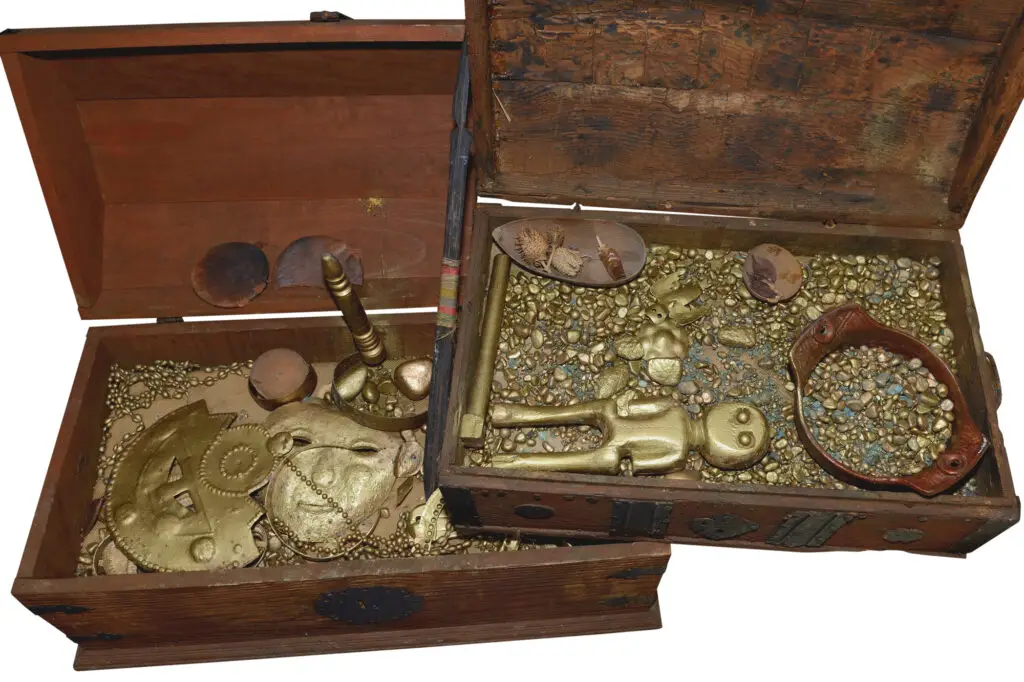It’s impossible to picture the golden age of piracy without the quintessential image of a pirate, eye-patch adorned, kneeling on a desolate island, shovel in hand, burying treasure chests full of sparkling gold coins and precious gemstones. But have you ever paused and wondered why? Why is treasure often buried? Is it just a romanticized fiction born out of Hollywood, or does this narrative have some historical footing?
In this article, we venture into the intriguing world of buried treasures, exploring the reasons behind these subterranean stashes of wealth. We will dive into three main motivations: the preservation and safeguarding of wealth, strategic measures during times of conflict, and the desire for a safe and secret store of illegal gains.
Delving deeper into the mystifying realm of hidden treasures, we will also investigate the age-old connection between pirates and buried booty, debunking myths and presenting facts. Pirates have, for centuries, been both marveled and feared. Their tales of adventure, lawlessness, and their close ties with buried treasure have kept us fascinated for generations. We will bring these sea-faring outlaws into focus, discussing their habits and their actual practices around burying treasure.
Lastly, but certainly not least, prepare yourself to journey to the discovery of the biggest treasure trove ever found. It’s a tale that may seem plucked right from the pages of a gripping adventure novel – a discovery that forever changed our understanding of hidden wealth and the lengths people have gone to safeguard their fortunes.
So, whether you’re a budding archaeologist, a history buff, or a treasure-hunting enthusiast, or if you’re simply captivated by tales of mystery and adventure, this article promises to whisk you away on an exciting voyage. By the end, we hope to have answered not just the ‘where’ and ‘how’, but the all-important ‘why’ of buried treasure. So grab your metaphorical shovels and ready yourself for a deep dig into the enchanting world of buried treasure.

Reasons Why Treasure Is Buried
Offering To Gods
Throughout history, the practice of burying treasures as offerings to gods or divine entities has been prevalent in many cultures across the globe. This ritual, known as a votive offering, was performed for several reasons, all rooted in the human desire for divine intervention or favour.
Propitiation: In many ancient societies, it was believed that gods controlled the natural elements and human fortunes. By burying valuable offerings, people hoped to appease these deities, warding off their wrath or seeking their benevolence. The treasures buried were often considered a sacrificial act to demonstrate reverence and humility, and to avoid divine retribution.
Petitioning for Blessings: People would bury treasure as a way of petitioning their gods for blessings. This could range from good health, bountiful harvests, victory in battles, to protection from evil. The value of the buried item was believed to correspond with the magnitude of the favor requested.
Gratitude: Burying treasure was also seen as a way of showing gratitude for blessings received. If an individual or community experienced prosperity, they might bury treasure as a form of thanksgiving, believing that their success was a result of divine intervention.
Ritual Burials: In some cultures, treasures were buried with the deceased as offerings to the gods of the underworld, ensuring a peaceful afterlife for the departed. The Egyptians, for instance, filled their tombs with a wealth of artifacts and riches, aiming to equip the dead for their journey into the afterlife.
Sacred Sites: Treasures were also buried at sacred sites to mark them as places of religious or spiritual significance. These hidden offerings were meant to consecrate the space, making it a suitable venue for worship or spiritual gatherings.
It’s important to note that these practices, while seemingly alien to modern secular societies, were a vital part of people’s spiritual lives in ancient times. They reveal how humans attempted to make sense of their world and influence their destinies by engaging with the divine through the material wealth they valued.
To Hide The Treasure For Safekeeping
Burying treasure for safekeeping is a practice that dates back to ancient times and was commonly used in periods of uncertainty, conflict, or danger. The core idea is simple – you hide your valuables where others can’t find them, protecting them from theft, pillage, or loss. Let’s delve into how this practice worked and why it was often deemed necessary.
Secrecy: Buried treasure is hidden treasure. By burying their wealth underground, individuals could keep its location secret, shielding it from prying eyes. The geographical locations were often only known to the owner or passed down within families or trusted circles as guarded secrets.
Protection: Burying treasure was also a protective measure. In a time when bank vaults and home safes weren’t common, burying treasure was a practical way to protect valuables from being looted, particularly during wars, invasions, or periods of social instability.
Portability: For those constantly on the move, such as nomadic tribes or seafaring pirates, burying treasure provided a way to lighten their load while ensuring their wealth was securely stashed. These individuals would often bury their treasure in remote or hard-to-reach locations, intending to return for it at a later, safer time.
Preservation: The earth can act as a natural preservation chamber. Many materials, especially gold and other precious metals, can remain unchanged underground for centuries. By burying these items, people could ensure their wealth was not only hidden but also preserved for future use.
While burying treasure for safekeeping might seem like a practice confined to the annals of history or the plots of adventure novels, it’s worth noting that it still occurs in some form today. Modern ‘time capsules’, buried with items of the present era for future generations to discover, are a nod to this ancient practice of burying items for safekeeping.
Burials
The connection between burying treasure and burials can be traced back to ancient civilizations and their beliefs about death and the afterlife. It was widely practiced in various cultures with different connotations, largely stemming from the belief that earthly possessions, particularly items of value or personal significance, could accompany the departed into the next life. Here’s a closer look at how this practice was manifested:
Egyptian Pharaohs: Ancient Egypt is a well-known example of wealth being buried with the deceased. Pharaohs were often entombed with vast amounts of treasure, ranging from gold and precious stones to artifacts of daily use, intended for use in the afterlife. The belief was that the deceased would continue to live in the underworld, and these buried items would ensure their comfort and prosperity.
Chinese Emperors: The Chinese also had the practice of burying emperors with treasures and even terracotta armies, as seen in the tomb of Emperor Qin Shi Huang. These were meant to protect and serve the emperor in the afterlife.
Viking Burials: The Vikings buried their dead with their belongings, including weapons, jewelry, and even ships. The grave goods were considered necessary for the departed to maintain their status and lifestyle in the afterlife.
Native American Cultures: Many Native American cultures also buried their dead with personal belongings and symbolic items, believed to guide or aid the departed in their journey to the spirit world.
These burial practices indicate a common human desire across diverse cultures – to safeguard and perpetuate one’s status, wealth, and identity, even in death. The treasures buried with the deceased were seen as part of their spiritual journey, a testament to their earthly life, and a preparation for what lay beyond. It’s a practice that combines elements of superstition, tradition, and the deeply human concern with mortality and what follows it.
Why Did Pirates Bury Treasure?
While the image of pirates burying their ill-gotten gains on deserted islands is a popular one, historically speaking, it’s largely a myth propagated by literature and popular media, like Robert Louis Stevenson’s classic novel “Treasure Island.”
In reality, pirates burying their treasure was quite rare. Pirates led dangerous and often short lives, with the threat of death at sea or execution on capture constantly looming. The need for quick access to their plunder for immediate gratification and to finance their operations left little incentive to bury their loot for future use.
That said, there are a few recorded instances of pirates burying their treasure, usually for specific strategic reasons:
Safekeeping: In the rare instances where pirates had amassed considerable wealth, they might bury some of their treasure to protect it. Pirates were always at risk of being captured or killed, and a hidden stash could ensure some measure of security or a nest egg to return to in times of need.
Avoiding Capture: If a pirate crew found themselves pursued by navy or pirate hunters, they might bury their treasure to lighten their ship for a quicker escape, with plans to retrieve it later.
Power Play: In some cases, pirate captains could use buried treasure as a tool to control their crew. By keeping the treasure’s location a secret, the captain ensured his value and lessened the chance of mutiny.
One famous example of a real-life pirate who did bury his treasure is Captain William Kidd, who buried part of his loot on Gardiners Island in New York. His intention was likely to use it as a bargaining chip in his trial for piracy in England. However, it’s worth noting that Kidd’s case was the exception rather than the rule. Most pirates spent their loot as quickly as they stole it, living a life of reckless abandon rather than careful planning and saving.
What Is The Biggest Treasure Found?
The biggest treasure ever found, in terms of both monetary value and historical significance, is believed to be the treasure of the Spanish galleon “Nuestra Señora de Atocha.”
The Atocha was part of the 1622 Spanish fleet carrying vast quantities of gold, silver, gems, and other valuable goods from the New World back to Spain. Unfortunately for the Spanish Crown, a hurricane off the Florida Keys sank the Atocha and much of the fleet. The ship remained lost at sea until it was rediscovered by treasure hunter Mel Fisher in 1985 after a 16-year-long search.
The sunken treasure recovered from the Atocha was staggering. It included an estimated 40 tons of gold and silver, hundreds of thousands of Spanish silver coins known as “pieces of eight,” and a wide array of precious gems. The value of the treasure trove, though difficult to precisely quantify due to the historical and cultural value of many artifacts, has been estimated at around $450 million.
The discovery of the Atocha treasure has had a significant impact on our understanding of maritime history, and it stands as a testament to the vast wealth transported across the oceans during the age of exploration. The story of the Atocha continues to captivate the world, embodying the eternal human fascination with treasure, adventure, and the allure of the unknown.

